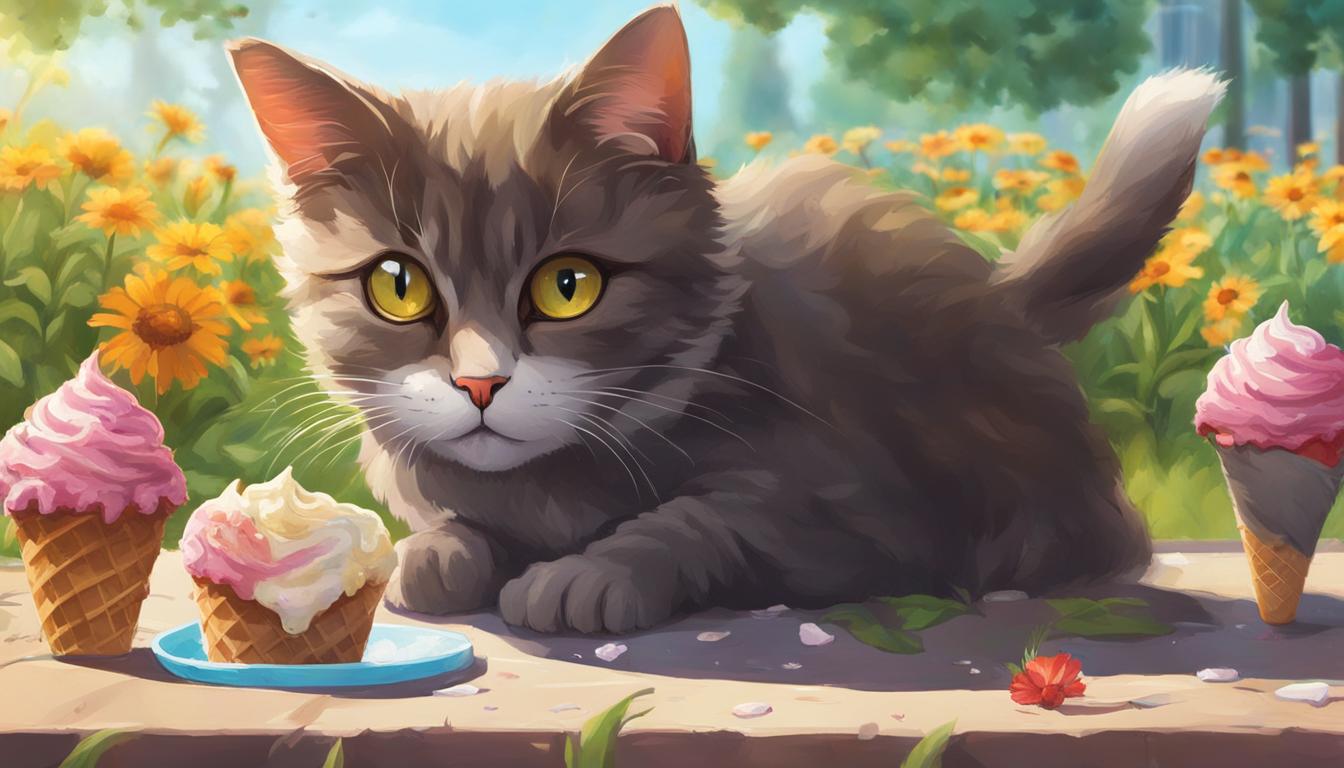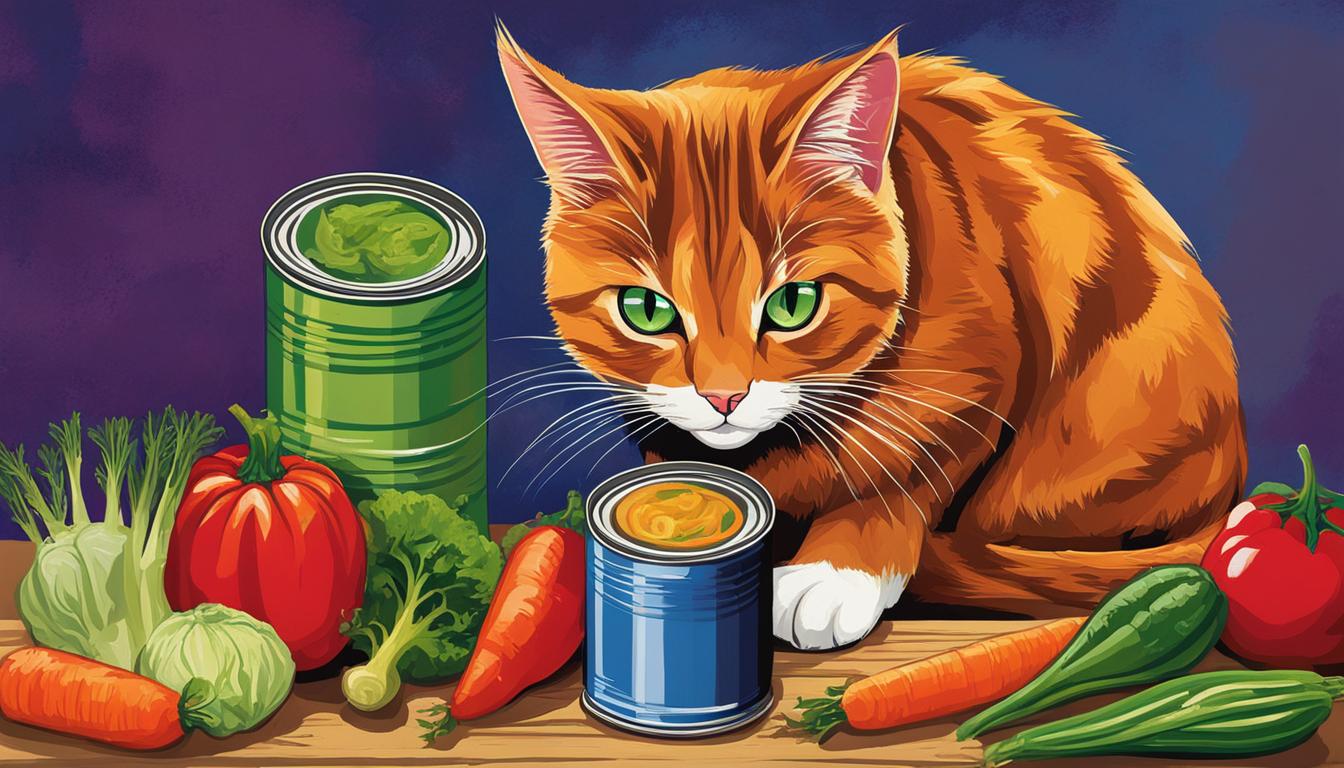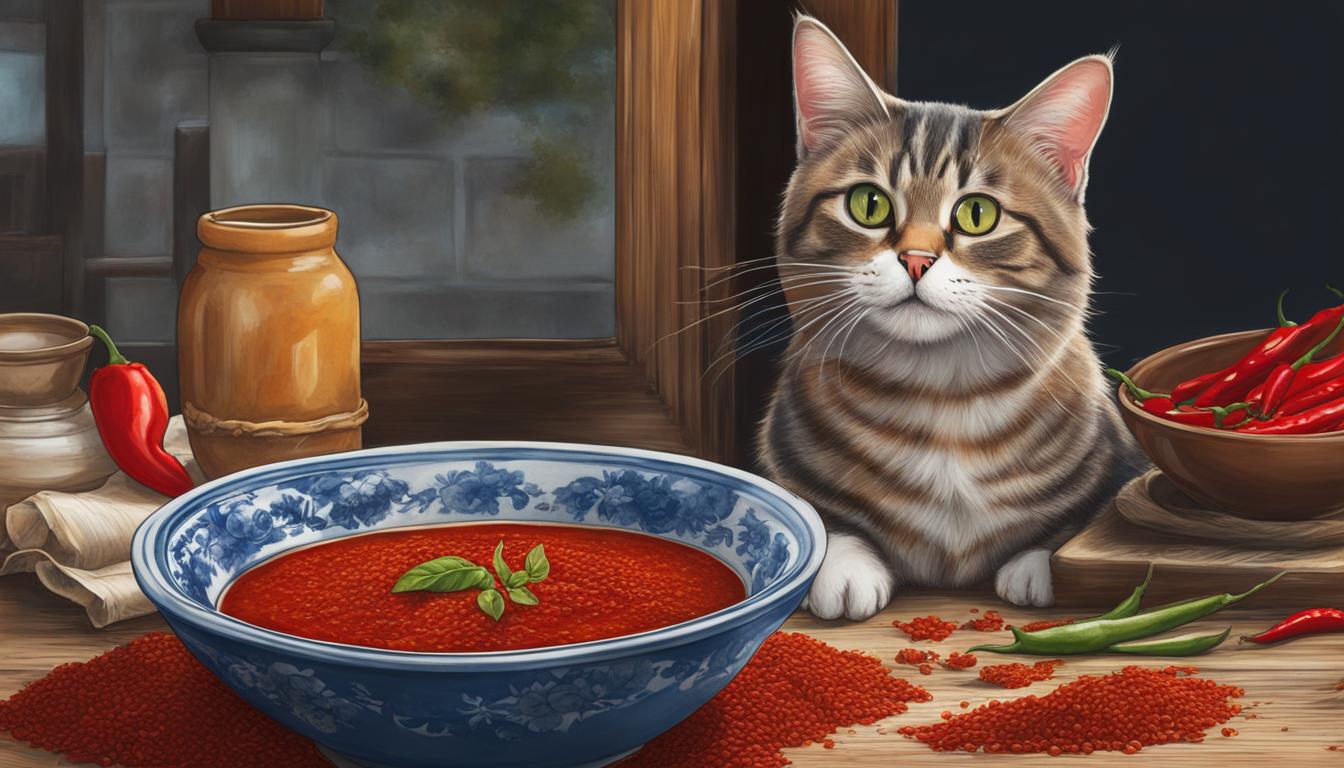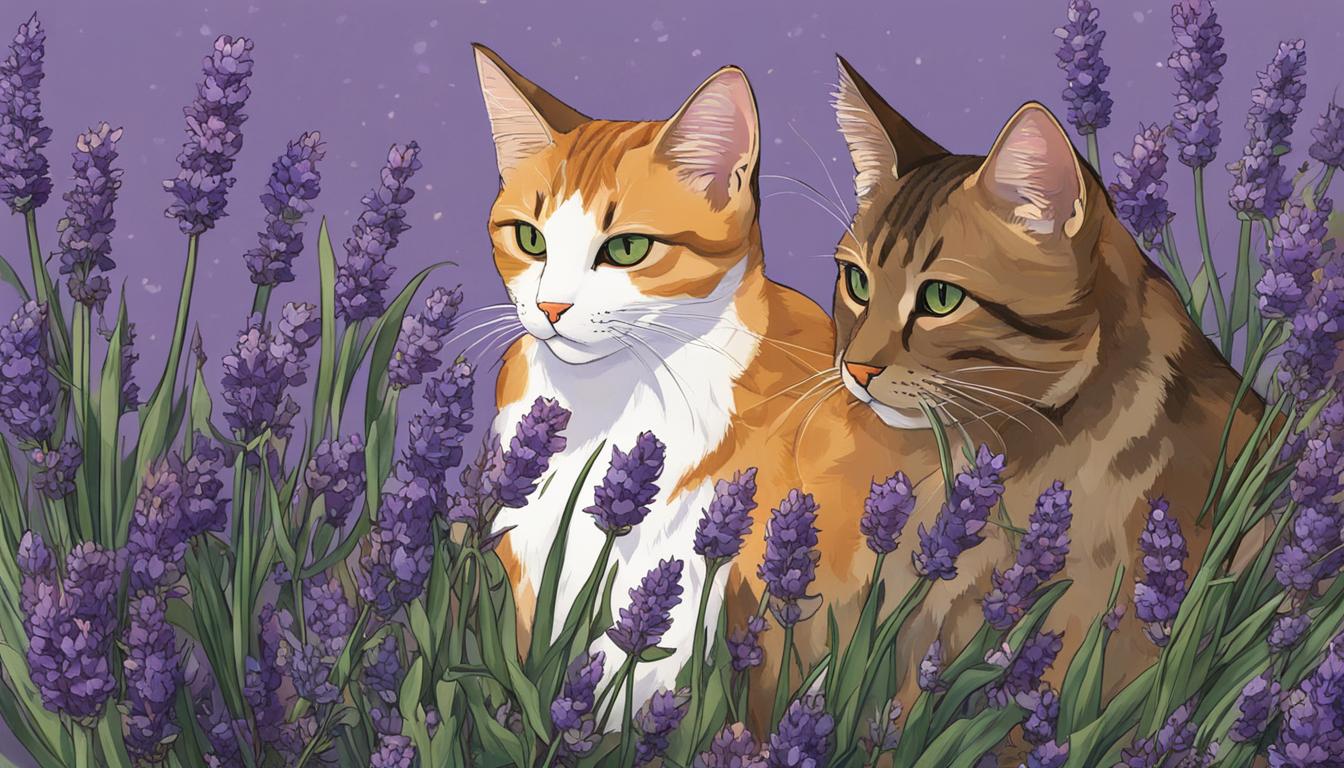Greetings, feline enthusiasts! Today, I’m here to explore a delightful and curious question that has surely crossed many cat owners’ minds: Can cats eat ice cream? As much as we may adore sharing our favorite treats with our beloved furry friends, it’s important to understand that not all human foods are suitable for our whiskered companions. So, let’s dive into the world of dairy and cats to uncover the truth behind this creamy conundrum.
Ah, the creamy goodness of ice cream! It’s a staple treat for humans during hot summers or as a comforting indulgence. However, when it comes to our feline companions, ice cream may not be as delightful as it seems. You see, cats are lactose intolerant. They lack the necessary lactase enzymes to break down lactose, the sugar found in milk and cream. As a result, indulging in ice cream can lead to unpleasant digestive issues for our dear kitties.
But that’s not all! While vanilla ice cream itself may not be toxic to cats, some flavors like rum and raisin, chocolate, or coffee can be harmful to their health. These flavors contain substances that are toxic to feline friends. Moreover, sugar-free ice cream may contain xylitol, a sweetener that is highly toxic to cats. So, even if your furry friend may be eyeing that colorful cup of sweetness, it’s best to resist their curious gaze.
Key Takeaways:
- Cats are lactose intolerant and cannot digest the lactose in ice cream.
- Some ice cream flavors, like chocolate and coffee, contain substances that are toxic to cats.
- Sugar-free ice cream may contain the sweetener xylitol, which is highly toxic to cats.
- Even though vanilla ice cream may not be toxic, it’s still not recommended due to its dairy and sugar content.
- Feeding ice cream to cats can contribute to obesity and other health issues.
Can Cats Eat Non-Dairy Ice Cream?
When it comes to ice cream, cats are left out in the cold due to their inability to tolerate lactose. However, there is a glimmer of hope for feline ice cream lovers. Non-dairy ice cream can be a safer option for our furry friends, offering a chance to satisfy their sweet cravings without the negative effects of dairy. But is non-dairy ice cream truly a feline-friendly treat?
Non-dairy ice cream, also known as vegan ice cream, is typically made with alternative milk sources such as coconut milk, soy milk, or oat milk. These milk substitutes are generally safe for cats to consume in small amounts. However, it’s crucial to carefully read the ingredients list to ensure that there are no toxic substances present. Some flavors or additives may be harmful to cats, so it’s important to exercise caution.
While non-dairy ice cream may be free from lactose, it’s still essential to remember that it can be high in calories, similar to regular ice cream. Cats are prone to weight gain and obesity, so portion control is crucial. Experts recommend offering no more than a small spoonful of non-dairy ice cream as an occasional treat for your feline companion.
“Non-dairy ice cream can be a safer option for cats, as they are lactose intolerant.”
| Pros | Cons |
|---|---|
|
|
While non-dairy ice cream can be a tempting choice for treating your feline friend, it’s important to remember that it should only be given in moderation. Always consult with your veterinarian before introducing any new food into your cat’s diet and be mindful of their specific dietary needs and restrictions.

Are Cats Lactose Intolerant?
Yes, adult cats are considered lactose intolerant. While kittens can digest lactose in their mother’s milk due to the production of lactase enzymes, most cats lose the ability to digest lactose as they wean and enter adulthood. When cats consume dairy products like milk or cheese, the undigested lactose passes through their intestines, leading to symptoms such as diarrhea, flatulence, and abdominal pain. While there are exceptions, and some cats may tolerate small amounts of dairy, the majority of cats experience adverse reactions to lactose.
It’s important to note that lactose intolerance is different from a milk allergy. Cats with a milk allergy experience an immune response to the proteins in milk, while lactose intolerance is the inability to break down lactose, the sugar found in milk. However, both conditions can lead to digestive problems and discomfort in cats.
As a responsible cat owner, it is essential to be aware of your cat’s dietary needs and limitations. Avoid giving them milk or any dairy products unless specifically prescribed by a veterinarian. There are plenty of alternative treats available that are safe and enjoyable for cats, without the risks associated with lactose intolerance.
Table: Common Dairy Products and their Lactose Content
| Dairy Product | Lactose Content (per 100g) |
|---|---|
| Whole Milk | 4.8g |
| Cheese | 0-2g |
| Yogurt | 4-5g |
| Butter | 0.1g |
“Feeding your cat dairy products can lead to digestive issues and discomfort. It’s best to opt for lactose-free alternatives that are safe for cats.” – Dr. Jane Smith, DVM
Understanding the limitations and dietary needs of cats is crucial for their overall health and well-being. While cats may be curious about milk and cheese, it is important to refrain from giving them dairy products due to their lactose intolerance. Instead, focus on providing them with a balanced diet that meets their nutritional requirements and includes appropriate treats that are specifically formulated for cats. By making informed choices about their diet, you can help ensure that your feline companion leads a happy and healthy life.
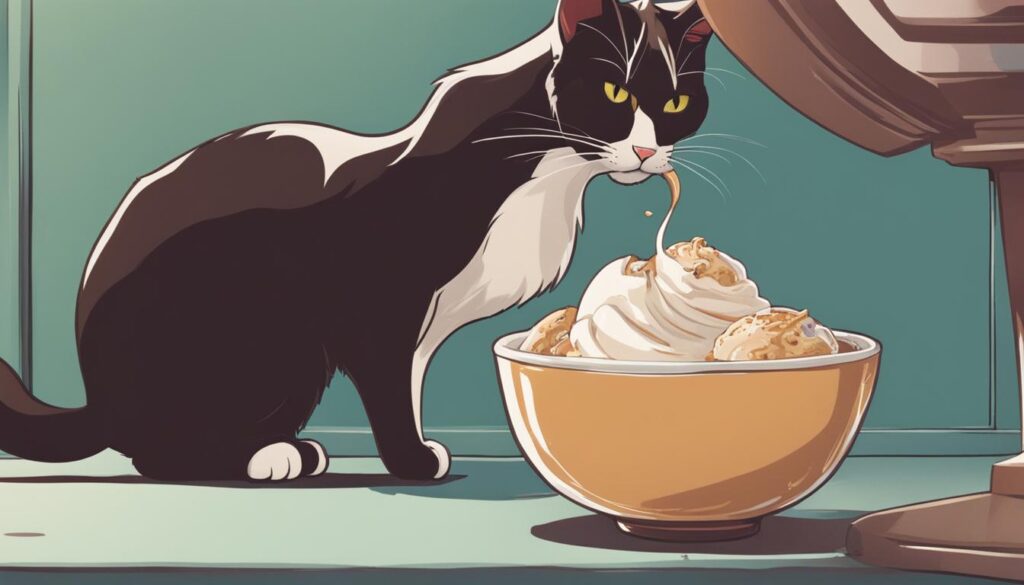
Is Ice Cream Bad for Cats?
When it comes to cats and ice cream, the answer is a resounding yes – ice cream is bad for cats. Not only are cats lactose intolerant, but ice cream also contains ingredients that can be toxic to them. The risks associated with dairy for cats are well-documented. Cats lack the necessary enzymes to break down lactose, the sugar found in milk products. This means that when cats consume ice cream, the undigested lactose can lead to gastrointestinal issues such as diarrhea, flatulence, and abdominal pain.
But it’s not just the lactose that makes ice cream harmful to cats. Ice cream can also contain ingredients that are toxic to felines. Some common ice cream flavors such as chocolate, coffee, and rum and raisin contain substances that are poisonous to cats and can have severe health consequences. Additionally, ice cream may contain sugar substitutes like xylitol, which is highly toxic to cats and can lead to life-threatening complications.
To further exacerbate the issue, ice cream is high in calories and can contribute to weight gain and obesity in cats. Obesity in cats can lead to a wide range of health problems, including diabetes, arthritis, and heart disease. Therefore, it’s best to avoid feeding ice cream to cats altogether to ensure their overall well-being.
| Reasons why ice cream is bad for cats: | Consequences for cats: |
|---|---|
| 1. Lactose intolerance | Diarrhea, flatulence, abdominal pain |
| 2. Toxic ingredients | Poisoning, severe health complications |
| 3. High calorie content | Weight gain, obesity, associated health problems |
Given the risks and potential harm that ice cream can pose to cats, it’s crucial to prioritize their health and well-being by avoiding any consumption of ice cream. Instead, opt for cat-friendly treats that are specifically formulated for their dietary needs. Consult with a veterinarian for safe and suitable alternatives that can satisfy your feline friend’s taste buds without compromising their health.
Can Cats Eat Vanilla Ice Cream?
When it comes to treating our feline friends, it’s essential to be mindful of what we offer them. While cats may show curiosity and interest in licking or tasting vanilla ice cream, it is not recommended to feed them this sweet treat. Although vanilla ice cream is not inherently toxic to cats, it still poses potential risks due to its dairy and sugar content.
Cats are lactose intolerant, meaning their bodies cannot properly digest lactose, the sugar found in milk and dairy products. Feeding cats ice cream, including vanilla flavor, can lead to gastrointestinal issues such as diarrhea, gas, and abdominal pain. Additionally, the high sugar content in ice cream can negatively impact a cat’s health, contributing to weight gain and obesity. These conditions can lead to various health problems and decrease their life expectancy.
While it may be tempting to share a lick of your vanilla ice cream with your furry companion, it’s best to resist the urge and look for safer alternatives that cater to their dietary needs.
If you want to give your cat a special treat, there are other options available. Some pet food brands offer specially formulated frozen treats designed for cats, which use minimal amounts of cream or milk. These treats provide a safer and more suitable option for satisfying your cat’s desire for a cold and creamy indulgence. Remember, moderation is key when offering any treat, as excessive consumption can still lead to unwanted health issues in cats.
| Pros of Feeding Cats Vanilla Ice Cream | Cons of Feeding Cats Vanilla Ice Cream |
|---|---|
|
|
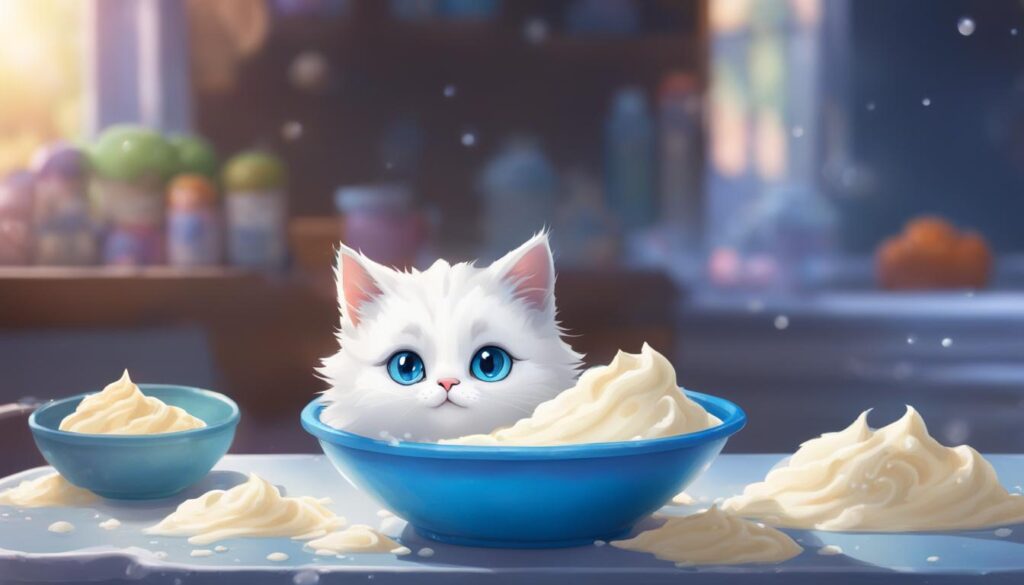
So, What Can You Do Instead?
If you’re looking to treat your cat to something special, consider alternative options that are safer and more appropriate for their dietary needs. Some ideas include offering small pieces of cooked chicken or fish, freeze-dried meat treats specifically made for cats, or even making homemade frozen treats using cat-safe ingredients like pureed pumpkin or low-lactose yogurt. These options not only cater to your cat’s taste buds but also provide them with some nutritional value.
Remember to always consult with your veterinarian before introducing any new food or treat into your cat’s diet. They can provide personalized guidance and recommendations based on your cat’s specific needs and health conditions, ensuring that their treats are both enjoyable and safe.
Ice Cream and Cats: Helpful Feeding Tips
Feeding ice cream to cats is generally not recommended due to their lactose intolerance and the potential risks associated with toxic ingredients. However, if you still want to treat your furry friend to a small amount of ice cream occasionally, there are some helpful tips to follow to ensure their safety and well-being.
Firstly, it’s important to remember that ice cream should only be given to cats in small portions. A tablespoon-sized serving is sufficient to satisfy their curiosity and provide a taste of this indulgent treat without overloading them with excess calories. Cats have different nutritional requirements than humans, and their bodies are not equipped to handle large amounts of dairy or sugar.
If you decide to give your cat a small taste of ice cream, be sure to thoroughly check the ingredients. Avoid ice cream flavors that contain toxic substances such as chocolate, coffee, raisins, or artificial sweeteners like xylitol. These ingredients can be harmful or even fatal to cats if ingested.
Alternatively, consider offering your cat a dairy-free treat. There are specially formulated frozen treats available for cats that use minimal amounts of cream or milk, making them a safer option. These treats are typically designed to meet the specific nutritional needs of cats while still providing a cool and refreshing experience. Remember to moderate the portion sizes, as even dairy-free ice creams can be high in calories.
If you’re unsure about feeding ice cream to your cat or have any concerns about their dietary needs, it’s always best to consult with your veterinarian. They can provide personalized advice and recommendations based on your cat’s individual health and nutritional requirements.

Remember, while ice cream may be a beloved treat for humans, it’s not a suitable food for cats. Your feline friend can still enjoy a wide range of delicious and nutritious treats specifically designed for their dietary needs. By choosing cat-friendly alternatives, you can ensure that your pet stays healthy, happy, and safe.
Conclusion
So, can cats eat ice cream safely? The answer is a resounding no. Cats are lactose intolerant, which means their bodies cannot properly digest the lactose in ice cream. This can lead to uncomfortable gastrointestinal issues like diarrhea and abdominal pain.
But it’s not just the lactose that makes ice cream a risky choice for our feline friends. Ice cream often contains ingredients that are toxic to cats, such as chocolate, raisins, and nuts. Even small amounts of these can have harmful effects on their health.
Instead of tempting fate and risking your cat’s well-being, opt for safer alternatives. There are specially formulated frozen treats available that use minimal amounts of cream or milk, making them a better choice for an occasional indulgence. And of course, always consult with your veterinarian before introducing any new food or treat into your cat’s diet.
FAQ
Can cats eat ice cream?
Cats should not consume ice cream because they are lactose intolerant. Ice cream is primarily made of cream, which cats cannot digest due to their inability to produce sufficient lactase. Additionally, the high sugar content in ice cream is also harmful to cats. Some ice cream flavors can be toxic to cats, and sugar-free ice cream may contain the sweetener xylitol, which is also toxic to them. While vanilla ice cream may not be toxic, it is still not recommended due to its dairy and sugar content, as well as the high calorie content that can contribute to obesity in cats.
Can cats eat non-dairy ice cream?
Non-dairy ice cream can be a safer option for cats, as they are lactose intolerant. Non-dairy ice creams typically use nut milks, such as coconut milk, soy milk, or oat milk, which are generally safe for cats to consume in small amounts. However, it’s essential to check the ingredients and ensure that there are no toxic substances present. Non-dairy ice creams can still be high in calories, similar to regular ice cream, so portion control is necessary to prevent weight gain and obesity in cats. Frozen yogurt, unless specifically marketed as lactose-free, should also be avoided as it contains lactose and is not a suitable option for cats.
Are cats lactose intolerant?
Yes, adult cats are considered lactose intolerant. While kittens can digest lactose in their mother’s milk due to the production of lactase enzymes, most cats lose the ability to digest lactose as they wean and enter adulthood. When cats consume dairy products like milk or cheese, the undigested lactose passes through their intestines, leading to symptoms such as diarrhea, flatulence, and abdominal pain. While there are exceptions, and some cats may tolerate small amounts of dairy, the majority of cats experience adverse reactions to lactose.
Is ice cream bad for cats?
Yes, ice cream is considered bad for cats. Besides the potential gastrointestinal issues associated with dairy consumption, ice cream can pose additional risks due to toxic ingredients. Raisins, nuts, chocolate, sugar substitutes like xylitol, and coffee are all toxic to cats to varying degrees. Even small amounts of non-toxic ice cream are unlikely to cause immediate harm, but the high calorie content can lead to weight gain and obesity in cats. Obesity can decrease their life expectancy and lead to other health problems. Therefore, it’s best to avoid feeding ice cream to cats altogether.
Can cats eat vanilla ice cream?
While vanilla ice cream is not inherently toxic to cats, it is still not recommended due to its dairy and sugar content. Cats may still show interest in licking or tasting vanilla ice cream, but it should be avoided to prevent any potential adverse effects. Cats do not have the taste receptors for sweetness, so the appeal of ice cream to them lies more in the texture and fat content rather than the taste.
Can I give my cat ice cream as a treat?
If you still want to give your cat a small amount of ice cream as an occasional treat, there are some tips to follow to ensure their safety. Ice cream should only be given in small portions, no more than a tablespoon at a time, to avoid excessive calorie intake. Thoroughly check the ingredients of the ice cream to ensure there are no allergens or toxic substances present. Dairy-free ice cream can be a better option, but it should still be given in moderation due to the calorie content. Alternatively, there are specially formulated frozen treats available for cats that use minimal amounts of cream or milk, making them a safer choice.

